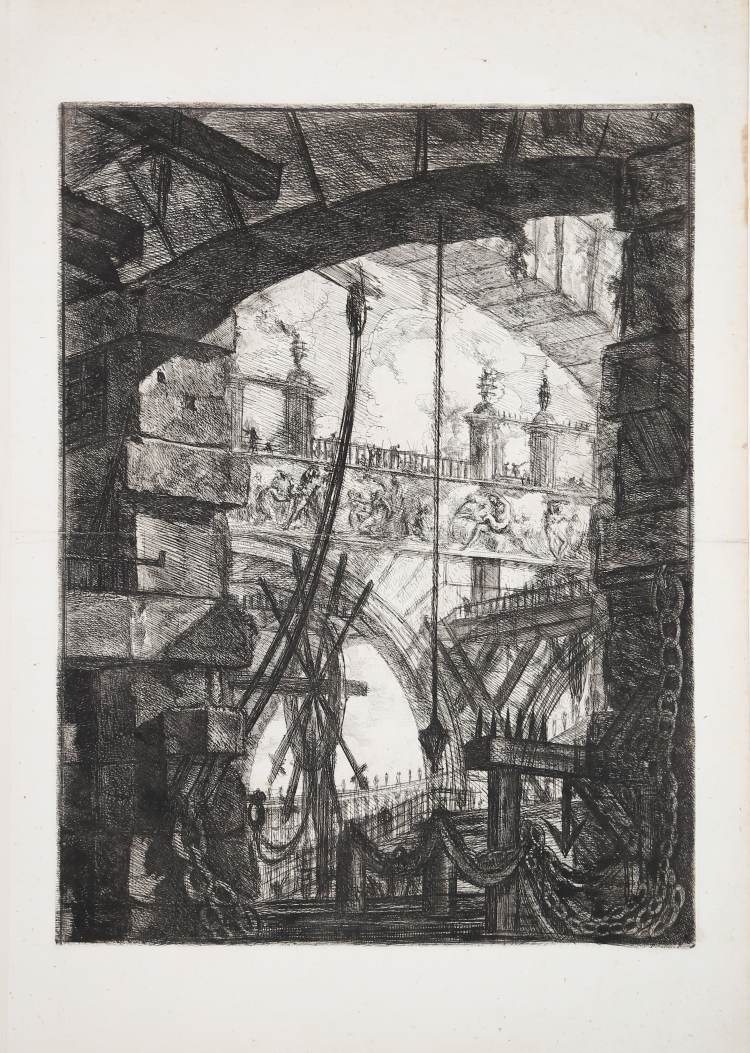



| Reference: | S30482 |
| Author | Giovan Battista PIRANESI |
| Year: | 1750 ca. |
| Measures: | 417 x 553 mm |


| Reference: | S30482 |
| Author | Giovan Battista PIRANESI |
| Year: | 1750 ca. |
| Measures: | 417 x 553 mm |
Etching, engraving, sulphur tint and burnishing, 1750, signed at lower lright. From the Carceri set, plate IV of the second edition, second issue.
Example in the third or fourth state of six described by Robison, from the contemporary roman edition (Robison dated to 1760/70).
A magnific impression, printed with black ink on contemporary laid paper without watermark, wide margins, usual central fold, otherwise perfect conditions.
Magnificent example, from the contemporary second edition, printed on thick paper typically used by Piranesi.
|
Robison 31 III-IV/VI, Hind 4, Focillon 27.
|
Giovan Battista PIRANESI (Mogliano Veneto 1720 - Roma 1778)
|
Italian etcher, engraver, designer, architect, archaeologist and theorist. He is considered one of the supreme exponents of topographical engraving, but his lifelong preoccupation with architecture was fundamental to his art. Although few of his architectural designs were executed, he had a seminal influence on European Neo-classicism through personal contacts with architects, patrons and visiting artists in Rome over the course of nearly four decades. His prolific output of etched plates, which combined remarkable flights of imagination with a strongly practical understanding of ancient Roman technology, fostered a new and lasting perception of antiquity. He was also a designer of festival structures and stage sets, interior decoration and furniture, as well as a restorer of antiquities. The interaction of this rare combination of activities led him to highly original concepts of design, which were advocated in a body of influential theoretical writings. The ultimate legacy of his unique vision of Roman civilization was an imaginative interpretation and re-creation of the past, which inspired writers and poets as much as artists and designers.
|
|
Robison 31 III-IV/VI, Hind 4, Focillon 27.
|
Giovan Battista PIRANESI (Mogliano Veneto 1720 - Roma 1778)
|
Italian etcher, engraver, designer, architect, archaeologist and theorist. He is considered one of the supreme exponents of topographical engraving, but his lifelong preoccupation with architecture was fundamental to his art. Although few of his architectural designs were executed, he had a seminal influence on European Neo-classicism through personal contacts with architects, patrons and visiting artists in Rome over the course of nearly four decades. His prolific output of etched plates, which combined remarkable flights of imagination with a strongly practical understanding of ancient Roman technology, fostered a new and lasting perception of antiquity. He was also a designer of festival structures and stage sets, interior decoration and furniture, as well as a restorer of antiquities. The interaction of this rare combination of activities led him to highly original concepts of design, which were advocated in a body of influential theoretical writings. The ultimate legacy of his unique vision of Roman civilization was an imaginative interpretation and re-creation of the past, which inspired writers and poets as much as artists and designers.
|